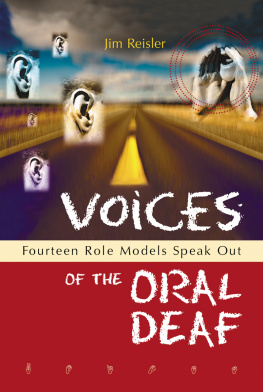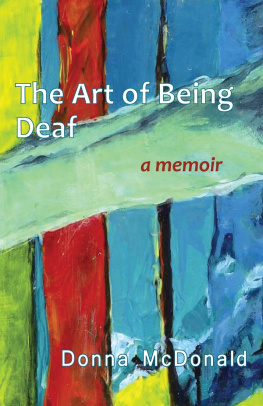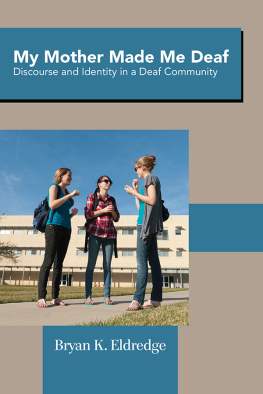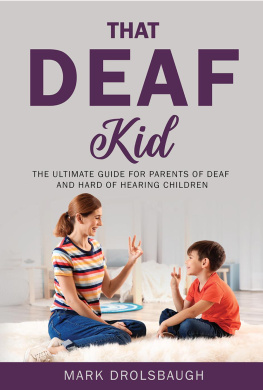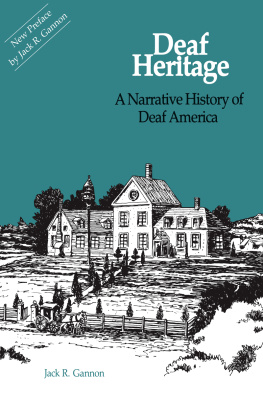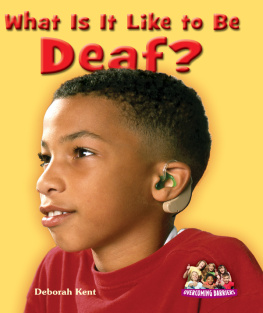
Also by Jim Reisler
and from McFarland
Cash and Carry: The Spectacular Rise and Hard Fall of C.C. Pyle, Americas First Sports Agent (2009)
Black Writers/Black Baseball: An Anthology of Articles from Black Sportswriters Who Covered the Negro Leagues, rev. ed. (2007)
Before They Were the Bombers: The New York Yankees Early Years, 19031915 (2002; paperback 2005)
Voices of the Oral Deaf
Fourteen Role Models Speak Out
JIM REISLER

McFarland & Company, Inc., Publishers
Jefferson, North Carolina
The authors royalties from the sale of this book will be donated to the League for the Hard of Hearing.
LIBRARY OF CONGRESS CATALOGUING DATA ARE AVAILABLE
BRITISH LIBRARY CATALOGUING DATA ARE AVAILABLE
e-ISBN: 978-0-7864-8413-3
2002 Jim Reisler. All rights reserved
No part of this book may be reproduced or transmitted in any form or by any means, electronic or mechanical, including photocopying or recording, or by any information storage and retrieval system, without permission in writing from the publisher.
McFarland & Company, Inc., Publishers
Box 611, Jefferson, North Carolina 28640
www.mcfarlandpub.com
For Tobie and Julia, with love
Acknowledgments
It takes a village.
Okay, its a clich, but its true. Although my experience in the oral deaf world is only at seven years and counting, I have been fortunate to meet and get to know a remarkable group of people, all of them dedicated to bettering the lives of deaf people.
The staff at the League for the Hard of Hearing are among those people. So are Lois Heymann, my familys mentor; Lori Kogan; Josie Rowley; and friends at the Deafness Research Foundation.
But in terms of this project, my most enduring thanks go to the role models interviewed here. Their willingness to examine their own lives to help others did more than fill the pages of this volume; it taught me a great deal about being a better parent and a better person. For those things alone, Ill always be grateful.
Preface
In June 1995, my wife, Tobie, and I heard the words we will never forget: Your daughter is deaf.
At the time, our daughter, Julia, was a week beyond her first birthday. We had suspected for several months that something was amiss: there was the day, several months before, when Tobie dropped some pots in the kitchen and Julia didnt turn around. Or the time when we were by the fire station in our town of Irvington, New York, when the alarm went off and Julia didnt respond.
Several times, we took Julia to the pediatrician, only to be told that she seemed fine. Once, the doctor rang a bell behind her and she happened to turn around. Deaf? Most of the traditional causes of deafness from meningitis and rubella have been practically wiped out, it was explained to us, leaving extraordinarily small odds that anything was wrong.
The story of a pediatricians misdiagnosis is a common one for deaf people and their families. So is the initial denial, particularly on the part of extended family members. Maybe its not really deafness, I remember family members telling us; maybe its just a blockage. Dont accept the answer and take Julia around to different experts, we were told. Sooner or later, youll find its something different. Anything but deafness.
Maybe it was really an infection, we tried to convince ourselves. Maybe it was a blockage and she needed tubes. Perhaps she just wasnt paying attention. Deaf? That wasnt within our realm of understanding. We had never even known anyone who was deaf.
For the parents whose child is diagnosed, the questions are a little more basic: Will your child ever be able to live a mainstreamed life? Will he or she have friends and be contented? Be able to go to school and fit in?
Today, we know the answers: Yes, yes and yes again.
In our case, we got lucky. Precisely one day and some 40 telephone calls after Julia was diagnosed, Tobie had found the League for the Hard of Hearing in New York City. A not-for-profit New York organization, the League, as its known, has a remarkable track record in helping deaf youngsters get along and thrive in mainstream society.
Tobie and I plunged into the oral deaf world like eager graduate students. We got involved in parent groups, went to conferences and read everything we could on the issue. Along the way, we made a solid and supportive network of friends ranging from deaf adults to other families with deaf children and a gifted group of professionals, including audiologists and speech therapists. We had the good fortune of meeting some extraordinary people who are deafpeople making a real difference, raising families and working in the community, in spite of their deafness.
This book has the first-person stories of some of those men and women. They are the all-star team, all of them success stories with a collective wisdom from which all of us can learn. Evenly divided between men and women, they include a healthy dose of diversity and span from young adulthood to maturity. Some are single, some married, and some have children while others dont.
Above all, they represent a range of oral deaf experience, from those who were born deaf to those who became deaf as children or as teenagers. Their main connection: All use speech as their primary means of communication, although most do know sign language.
As a parent of a hearing-impaired youngster, I am awed by these people. Their practical advice, unwavering sense of optimism and commitment to helping others are inspiring. Sharing their stories has been a real help to my family and will continue to be so: Sure, parenthood is exhausting, but in re-reading these pieces, I know that everything is going to be okay.
Jump ahead nearly some six years from the day Julia was diagnosed. In 1997, she received a cochlear implant at a time when her vocabulary was no more than a few dozen words. Today, Julia has a vocabulary in the thousands, and, as a mainstreamed second grader, is a good student. Her social calendar is chock-full, and she reserves particular passion, in no special order, for art, her beagle puppy and two cats, the American Girl book series, gymnastics, Britney Spears, most things pink and the New York Yankees.
In other words (and with a nod to a justifiable degree of parental bias), Julia, at the age of nine, is a connected, interesting little personso much so that I often try to step back to pinch myself when taking stock of how far she has come in such a short time.
A hearing colleague who read some of these interviews said her most lasting impression was that after a few pages, she stopped thinking of these people as having a physical handicap. Thats the idea: They cease being regarded as deaf, but are understood as role models giving all of us a better comprehension of what it takes to succeed and lead productive lives in the mainstream.
Introduction
It took seven days to create the world, it took us seven days to change it, was the joke, signed among Gallaudet University students back in 1988, when their protests successfully convinced the universitys board of directors to appoint its first deaf president.
At the time, those students were euphoric: they had faced down the administration winning what became recognized in time as an important, symbolic victory for deaf rights. The standoff drew headlines around the world and was generally considered the birth of a movement called Deaf Culture, an expression of solidarity among deaf people emphasizing their right to sign and be treated as a culture and not as disabled.
Next page
